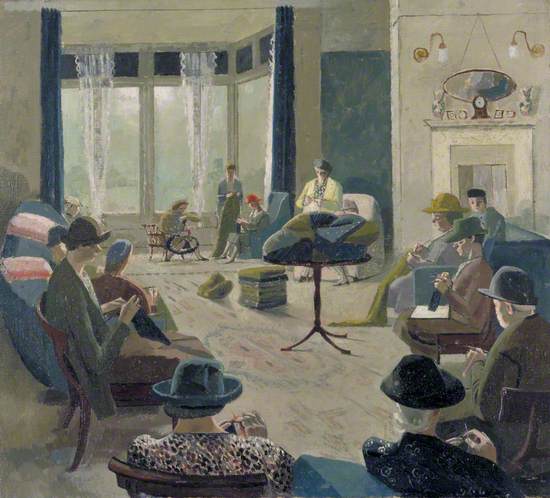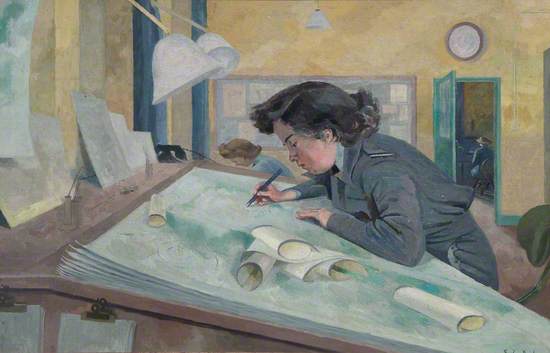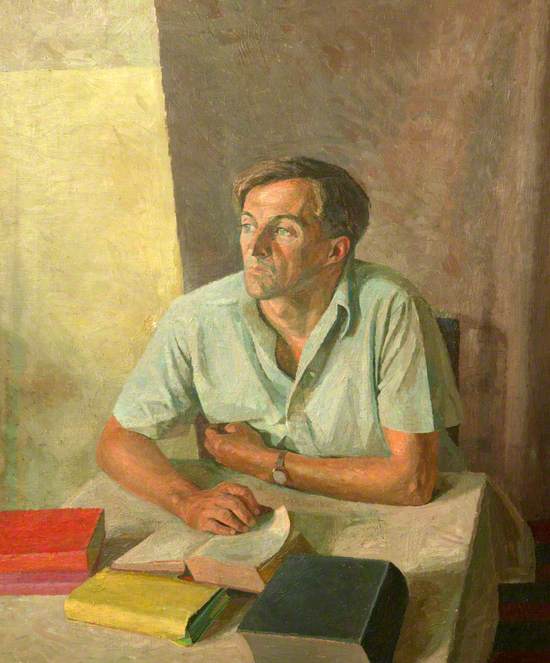Celebrating the life and work of Evelyn Dunbar (1906-1960), from her younger years to becoming the only woman artist salaried by the War Artists' Advisory Committee during the Second World War, and beyond.
The sketchbooks of Evelyn Dunbar are currently being digitised and added to www.flickr.com/ocmch. These items, along with other material held by the Centre, are available for consultation and use in academic or popular research.
Early Years
Evelyn Mary Dunbar (1906-1960) was born to William and Florence Dunbar on 18 December 1906 in Reading, Berkshire.
The youngest of five children, and encouraged by her mother (herself an amaetur artist), Dunbar’s artistic skills flourished from an early age. She was educated at Rochester Grammar School for Girls, then at Rochester School of Art; Chelsea School of Art; and latterly the Royal College of Art between 1929 and 1933.
Sir William Rothenstein, Principal of the Royal College of Art, described Dunbar as having “real genius”.
1958

Self Portrait
Artwork on loan from a private collection.
Pre-War work
Dunbar then started work on murals at Brockley County Secondary School, along with a handful of other College students and one of Dunbar’s tutors, Charles Mahoney.
One of her earlier works, Study for Decoration: Flight 1930, was purchased by The Tate in 1940. Along with these murals, Dunbar’s best known early works include illustrations for Gardeners’ Choice (Routledge, 1937); and the Gardener’s Diary for Country Life magazine in 1938.
Woman with a Scroll of Paper
A study for the Brockley Murals.
Evelyn Mary Dunbar (1906–1960)
Oil on paper
H 30.1 x W 24.5 cm
Tullie House Museum and Art Gallery
Wartime Work
In April 1940, Dunbar was appointed as an official war artist by Sir Kenneth Clark’s War Artists’ Advisory Committee (WAAC).
Her brief was to record the work of civilian contributions to the war effort on the home front, with Dunbar primarily focusing on the work of women. By the end of the war in 1945, she had had some forty works accepted by the WAAC, and these are now found in collections around Britain, including the Imperial War Museum and The Tate. Dunbar was the only woman in receipt of a regular salary from this body.
It was during the Second World War that Dunbar met her future husband, RAF Flying Officer Roger Folley.
A Knitting Party
Evelyn Mary Dunbar (1906–1960)
Oil on canvas
H 45.7 x W 50.8 cm
IWM (Imperial War Museums)
St Thomas's Hospital in Evacuation Quarters
Evelyn Mary Dunbar (1906–1960)
Oil on canvas
H 91.4 x W 152.4 cm
IWM (Imperial War Museums)
Section Officer Austen, Women's Auxiliary Air Force Meteorologist
Evelyn Mary Dunbar (1906–1960)
Oil on canvas
H 50.2 x W 76.2 cm
Royal Air Force Museum
'Victory' and Peace Time
When the war ended, the Folleys relocated to Oxfordshire, with Roger working as an agricultural economist at the University of Oxford, and Evelyn working part-time at the Ruskin School of Art and the Oxford College of Art (which evolved into Oxford Brookes University).
Dunbar was also appointed as Artist in Residence to Bletchley Park College, a newly founded teacher training college stationed in the disused codebreaking buildings.
Initially designing an extensive mural for the main dining hall at Bletchley, her declining health prevented her from completing this work. She then designed the Alpha and Omega panels for the College instead, which are still installed in its Library (which relocated to Wheatley in 1966).
Later portrait of Roger Folley
Evelyn Mary Dunbar (1906–1960)
Oil on canvas
H 76.5 x W 66.4 cm
Manchester Art Gallery
.

Preliminary Sketch
A preliminary work for the murals at Bletchley Park which were never created in full.
.

Preparatory Sketch, 'Alpha and Omega'
A double-sided sketch for the Alpha and Omega panels, now in the University Library on our Wheatley campus.
.

Alpha
The finished Alpha panel.
.

Omega
The finished Omega panel.
Legacy
Following a short illness, Dunbar died suddenly on 10 May 1960.
A significant proportion of her work was then mostly hidden on a family estate in Kent until an appearance of another work on the BBC’s Antiques Roadshow in 2013, at which point expert Rupert Maas described Dunbar as “perhaps an unknown artist”. This was followed by the discovery of some 500 works in an attic, including the preparatory works for Alpha and Omega (then purchased by Oxford Brookes University); an exhibition at Pallant House Gallery; and two books - an exhibition catalogue by Liss Llewellyn, and a critical biography by Christopher Campbell Howes (Dunbar’s nephew).
In 2021, a further twenty-two sketchbooks were discovered on the family estate, and purchased by Oxford Brookes University.
These have since been conserved, and placed alongside these other works by Dunbar already owned by the University.
Totalling over 800 works, this is the largest collection of work by Dunbar anywhere in the world.
An in-person exhibition accompanying a day conference, The Oxford Centre for Methodism and Church History (Oxford Brookes University), which cares for these works by Dunbar, invites you to join us in Rediscovering Evelyn Dunbar: a fascinating woman; an excellent, underappreciated artist; and the only salaried woman war artist.





